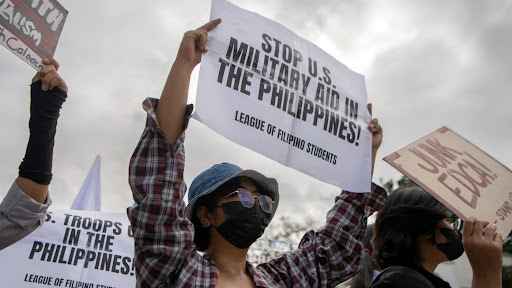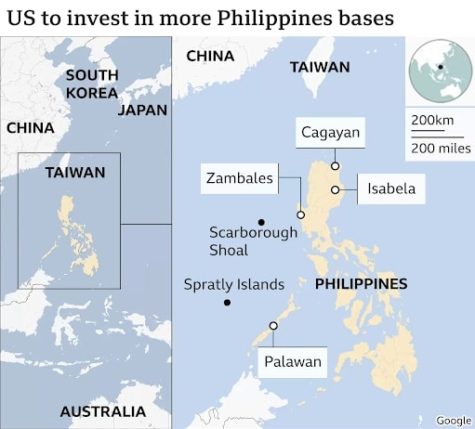Military Aid in the Philippines

Filipinos protesting against increased U.S. military influence.
Potential locations of the four new U.S. bases on Luzon (the Armed Forces of the Philippines. )
The United States and the Philippines finally sealed an agreement to station U.S. bases in the Philippines. This course of action contributed to the growing tensions between China and the U.S. within the South China Sea. Already, the U.S. had practically surrounded China, a strategy attributed to enclosing China and providing protection for Taiwan in case of a possible attack. As a result of this agreement, there was backlash from discontented Filipinos’ and Chinese’s stance on the matter.

The agreement was to settle four bases on Philippine territory; three of the new bases will potentially be on the Luzon islands located in the northern part of the Philippines. The U.S. has already established bases in Japan and South Korea, giving them an advantage by closing the gap and surrounding China with the acquisition of the Philippines. What this entails for the U.S. is a barrier against China in the South China Sea and availability to Taiwan.
On Feb. 2, President Ferdinand Marcos Jr and the U.S. Secretary of Defense Llyod Austin came together at Camp Navarro to discuss relations between the Philippines and the U.S. to finalize the agreement and implement military cooperation. The Enhanced Defense Cooperation Agreement, also known as EDCA, is a previous military agreement between the Philippines and the U.S. However, the settlement of bases further advances the alliance.
Disapproval of the U.S. and Philippine military relations developed from two groups; China and Philippines’ citizens. The New York Times collected from Nao Ming, China’s spokeswoman for the foreign ministry, stated, “Out of self-interest, the United States continues to strengthen its military deployment in the region with a zero-sum mentality, which is exacerbating tension in the region and endangering regional peace and stability.”
Protests in the Philippines erupted as the U.S. once again made a presence in the Philippines. Such opposing views were rooted in past U.S. military treatment of Filipinos, NPR Wabe documents Liza Maza, a secretary of the International League of Peoples’ Struggle, that there were reports of “past and continuing about violence against women and the LGBT community in relation to the presence of U.S. troops.”
The better-received side of the whole situation was none other than the United States itself, a statement from Washington described the movement would “allow more rapid support for humanitarian and climate-related disasters in the Philippines, and respond to other shared challenges.”
In the end, the presence of the United States military in the Philippines was a game changer for all those involved, Taiwan, China, the Philippines and the U.S. Was the agreement a strengthening in bonds or a lesson towards China? The next move regarding these countries anticipates steps toward a future of either destruction or peace.

Good day, my name is Janis Parry and this is my second year in journalism. I am a senior with optimistic ambitions about my future and this class...











